
Chalcid wasps are insects within the superfamily Chalcidoidea, part of the order Hymenoptera. The superfamily contains some 22,500 known species, and an estimated total diversity of more than 500,000 species, meaning the vast majority have yet to be discovered and described. The name "chalcid" is often confused with the name "chalcidid", though the latter refers strictly to one constituent family, the Chalcididae, rather than the superfamily as a whole; accordingly, most recent publications (e.g.,) use the name "chalcidoid" when referring to members of the superfamily.

Bandwings, or band-winged grasshoppers, are the subfamily Oedipodinae of grasshoppers classified under the family Acrididae. They have a worldwide distribution and were originally elevated to full family status as the Oedipodidae. Many species primarily inhabit xeric weedy fields, and some are considered to be important locusts:
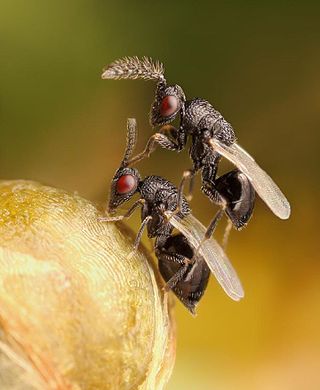
The Eurytomidae are a family within the superfamily Chalcidoidea.

Eurybrachidae is a small family of planthoppers with species occurring in parts of Asia, Australia and Africa. They are remarkable for the sophistication of their automimicry.
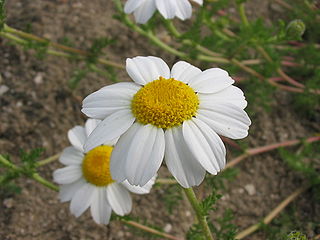
Anacyclus clavata also known as Camomilla tomentosa, Pusteni targok, vit bertram, white anacyclus and white buttons is a member of the genus Anacyclus and the tribe Anthemideae and family Asteraceae.

Gomphus clavatus, commonly known as pig's ears or the violet chanterelle, is an edible species of fungus in the genus Gomphus native to Eurasia and North America. Described by Jacob Christian Schäffer in 1774, G. clavatus has had several name changes and many alternative scientific names, having been classified in the genus Cantharellus, though it is not closely related to them. The fruit body is vase- or fan-shaped with wavy edges to its rim, and grows up to 15–16 cm wide and 17 cm tall. The upper surface or cap is orangish-brown to lilac, while the lower spore-bearing surface, the hymenium, is covered in wrinkles and ridges rather than gills or pores, and is a distinctive purple color.

The Phaneropterinae, the sickle-bearing bush crickets or leaf katydids, are a subfamily of insects within the family Tettigoniidae. They are also known as false katydids or round-headed katydids.
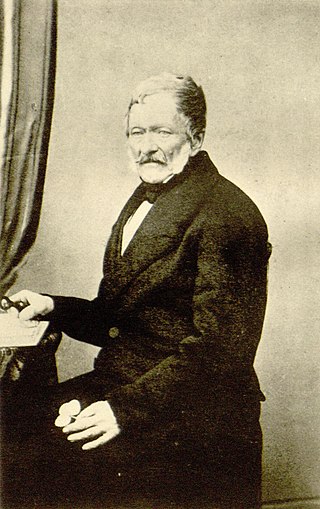
Jean Baptiste Henri Joseph Desmazières was a merchant of Lille and an amateur mycologist. He was the editor of the scientific journals "Annales des sciences naturelles" and the "Bulletin de la société des sciences de Lille".
Ochetellus democles is a species of ant in the genus Ochetellus. Described by Francis Walker in 1839, the ant was originally thought to be a small wasp based on a male collected by Charles Darwin. It was first recognised as an ant in 1988.

Megastigmus is a genus of minute wasps. There are more than 134 described species, more than half of which undergo larval development within the seeds of trees and shrubs.
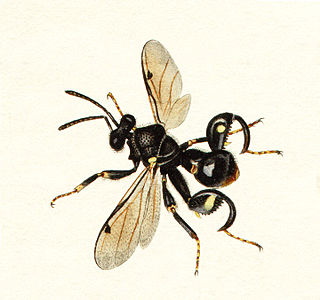
Chalcis is a wasp genus in the subfamily Chalcidinae.

Cleonymus is a genus of wasps in the family Cleonymidae. There are more than 40 described species in the genus, which has been recorded on every continent except Antarctica.
Ortalis is an historic genus of Ulidiid or picture-winged flies, first described by Fallén in 1810. It served as the type genus for the family Ulidiidae, which was called Ortalidae at the time. In 1932, it was pointed out by Adlrich that the name Ortalis was preoccupied by a genus of birds which had been named by Merrem in 1786. The name of the fly family was therefore revised, with some authors calling it Otitidae until Ulidiidae was settled on as standard. The genus itself was found to be paraphyletic, and all of its species have been reassigned to other genera, some in the Ulidiidae, and some in other Tephritoid families. In the following list, the species are organized according to the families and genera to which they have been reassigned.

Leucospis dorsigera is a species of wasp belonging to the family Leucospidae.

Leucospis is a genus of wasps belonging to the family Leucospidae. Most species are brightly coloured with yellow and black patterning and about 2 cm long. They have characteristically enlarged femurs on the hind leg, with the lower margin toothed. The wings have a longitudinal fold and the long ovipositor is bent over their backs above the abdomen or metasoma. They are parasitic on wasps and solitary bees that construct cells and provision food for their offspring. The Leucospis larvae live and grow as ectoparasites of the host larvae. Usually, only one parasite emerges from a single cell. The genus Micrapion from South Africa is very closely related, and phylogenetic studies suggest merging of the two genera. The genus Leucospis is found across the world in the tropical regions.

Euperilampus is a genus of chalcid wasps in the family Perilampidae. There are about 18 described species in Euperilampus.
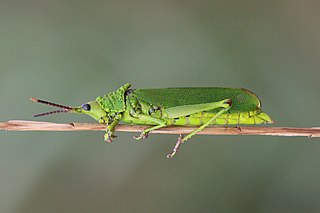
The Pyrgomorphinae are a subfamily of grasshoppers in the family Pyrgomorphidae. Species are found in, predominantly in the warmer regions of: Central and South America, southern Europe, Africa, Asia, Australia and Pacific Islands. The type genus is Pyrgomorpha and names dates from "Pyrgomorphiden" by Brunner von Wattenwyl, 1874. The first use of Pyrgomorphinae was by Krauss in 1890.

Dirhinus is a genus of parasitic wasps in the family Chalcididae. The genus has a worldwide distribution.
Callitula is a genus of insects belonging to the family Pteromalidae.
Plutarchia is a genus of chalcid wasp in the subfamily Eurytominae. Alexandre Arsène Girault first circumscribed the genus in 1925; its name honors Plutarch. The genus initially only comprised its type species, P. bicarinativentris, found in Australia. Subsequent species from South Asia and Nigeria have been described and transferred to Plutarchia.
















